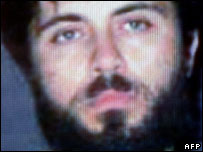|
|
|
Abu Maysara confirmed killed near Samarra. AFP photo. |
The regions around Samarra and Tarmiyah in Salahadin province continues to be a flashpoint for raids against senior al Qaeda operatives and propaganda cells. US forces have confirmed killing a senior Syrian al Qaeda leader near the city, and another media cell was dismantled in the city. As the US targets al Qaeda’s media operations, al Furqan released two new products over the past several days, including a tape by Abu Omar al Baghdadi.
Multinational Forces Iraq has confirmed killing Abu Maysara, a Syrian al Qaeda in Iraq leader. Maysara “was a member of Abu Ayyub al Masri’s inner circle and served as a senior advisor,” Multinational Forces Iraq reported. “Maysara was specifically responsible for providing extremist spiritual guidance and rebuttal on terrorist matters, perverting Islamic faith to allow terrorism, murder and torture. He was also known to provide logistical support to al Qaeda operations and was a key leader in the al Qaeda in Iraq media network.” Maysara was a key aide to Abu Musab al Zarqawi, fought in the Second Battle of Fallujah, and was captured on November 29, 2004.
He escaped from prison during the March 2007 Badush prison break in Mosul. Al Qaeda claimed the Badush prison break was led by Abu Omar al Baghdadi, the leader of al Qaeda’s political front organization the Islamic State of Iraq. The Kurdish guards were overwhelmed by over 300 al Qaeda fighters and called US forces in Mosul for support. The prison housed several hundred high-value al Qaeda targets, and al Qaeda was able to free 140 of them. Also among those freed was Abu Tahla, the leader of al Qaeda in Mosul up until his capture in 2005. He was subsequently recaptured.
Maysara was killed during the November 17 raid on an al Qaeda in Iraq media cell near Samarra. Five other al Qaeda operatives were killed and 10 captured during the operation.
Coalition special forces teams continue to hunt al Qaeda in Iraq’s media cells. On December 4, Special Forces teams broke up cells in Samarra, Baqubah, and Baghdad. The Baqubah raid killed the leader of Diyala’s propaganda network. His predecessor was killed just 23 days prior.
On November 30, Coalition forces captured “a wanted individual believed to be a key member in al-Qaeda in Iraq’s media and propaganda network” near Sharqat. “Reports indicate the wanted individual may have been using the target area as a safe haven to re-establish the network after significant degradation by Coalition forces’ recent operations.”
On November 28, The Long War Journal identified the Samarra region as a media hub for al Furqan, al Qaeda in Iraq’s media operation, and noted al Qaeda may be relocating its media operations due to Coalition raids.
As the US continues to target al Qaeda in Iraq’s propaganda cells, al Furqan has released a new attack video and an audiotape from Abu Omar al Baghdadi, the fictitious leader of the Islamic State of Iraq. Al Furqan has now released four products in the space of a week after a nearly two-month lull.
The SITE Institute provides a summary of Baghdadi’s tape.
This speech, titled, “As for the Foam it Passes Away as Scum”, is the first message from Baghdadi after Osama bin Laden’s acknowledgement of mistakes made by Al Qaeda in Iraq, of which ISI [Islamic State of Iraq] is its current iteration. Baghdadi, too, recognizes these mistakes, and conveys that the Prophet Muhammad and his companions were not infallible, but the tribal leaders and Awakening Council members who combat the Mujahideen today do not have a stronger faith than they. In highlights of the speech, Baghdadi announces the formation of a new brigade, “Al Siddiq Brigades” to fight every “apostate and traitor”, and additionally announces an attack that will end on … January 29, 2008. … This attack involves bombings aimed at the “apostates” and members of Awakening Councils.”
Also, Baghdadi references a “new trick” by U.S. military forces in their focusing on the presence of foreign Mujahideen in Iraq and emphasizing that Iraq and its riches are to be for all Iraqis. Here he argues that only particular Iraqis are entitled to these benefits, not including the Yazidis and other sects, and the “agents” of Iran, Al-Mahdi Army and Badr Brigades.
The focus on the Awakening Councils highlights the serious threat this movement poses to al Qaeda. The establishment of the al Siddiq Brigades mirrors a tactic al Qaeda used in the fight against the Shia. Al Qaeda established the Omar Brigades to specifically target prominent Shia leaders and communities. The goal was to incite sectarian violence and foment a civil war.









6 Comments
Is this the same Abu Maysarah al-Iraqi that released al-qaeda in Iraq media statements when Zarqawi was still alive?
Shade,
It looks like it.
http://news.yahoo.com/s/nm/20071204/wl_nm/iraq_dc;_ylt=AuBTN2um2tgP3ro_AH2CO06ShMgF
>
Also, MNF-Iraq has identified the top ten AQI leaders killed or captured in November.
http://www.mnf-iraq.com/images/stories/Press_briefings/2007/December/071204_slides.pdf
Ooops
Here is the specific text from the article I was referring to above.
———-
Maysara usually signed off on al Qaeda in Iraq Web statements for Zarqawi, who was killed in a U.S. and Iraqi military raid in June 2006.
———–
The Thunder Run has linked to this post in the – Web Reconnaissance for 12/05/2007 A short recon of what’s out there that might draw your attention, updated throughout the day…so check back often.
Bill,
You had said that recent operations were similar to those right before the death of Zarqawi. For example use of AA by AQI which would indicate presence of high value targets. I am curious if that pattern has continued.
Buck,
While I haven’t seen recent reports of AA cells dismantled, the patterns do appear to be the same.